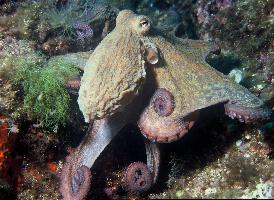
Description de l'animal
The Common octopus, scientifically known as Octopus vulgaris, is a fascinating and highly intelligent species of cephalopod that thrives in a variety of marine environments. This remarkable creature is widely distributed across the temperate and tropical waters of the world's oceans, making it one of the most well-known octopuses. The adaptability and cunning of the Common octopus have long intrigued scientists, marine enthusiasts, and cultures around the globe.Physical Attributes:
The Common octopus possesses a soft, spheroidal body, or mantle, which can reach up to 25 centimeters in length, with arms that extend much further, sometimes up to a meter. Its skin is highly malleable and contains specialized pigment cells known as chromatophores, which allow the animal to change color and texture in an instant. This ability not only serves as a means of communication but also as a highly effective form of camouflage against predators and when hunting prey. The octopus has eight arms, each lined with two rows of suckers that are capable of tasting and gripping objects with astonishing strength and dexterity.
Habitat and Behavior:
Common octopuses are solitary creatures that prefer to dwell in dens or crevices on the ocean floor. They are found at various depths, from shallow waters to the continental shelf, and their habitats include rocky, sandy, and muddy bottoms. They are skilled engineers of their environment, often using rocks and debris to fortify their homes.
These octopuses are nocturnal hunters, feeding primarily on crabs, clams, and other small marine creatures. They employ a variety of hunting techniques, such as pouncing on their prey or using their arms to probe into crevices. The Common octopus also has a remarkable ability to solve problems and use tools, such as using coconut shells and bottles for shelter.
Reproduction and Lifespan:
The life cycle of the Common octopus is both fascinating and somewhat tragic. After mating, the female lays thousands of eggs, which she meticulously cleans and guards until they hatch. This period marks the end of the female's life, as she does not eat during the incubation period and dies shortly after the eggs hatch. Males also die a few months after mating. The lifespan of a Common octopus is relatively short, typically ranging from one to two years.
Conservation Status:
Currently, the Common octopus is not considered endangered, thanks to its wide distribution and high reproductive rate. However, they are subject to pressures from fishing and habitat destruction. Their role as both predator and prey makes them a crucial component of marine ecosystems, and their population health is an indicator of the overall health of marine environments.
In Conclusion:
The Common octopus is a creature of mystery and marvel. Its intelligence, behavioral complexity, and adaptability make it one of the most intriguing species in the ocean. As research continues, we uncover more about these extraordinary creatures, reminding us of the importance of conserving the diverse life forms with whom we share our planet.
Nouvelles photos d'animaux
Top 10 des animaux
- Dolphin gull (Leucophaeus scoresbii)
- Diana monkey (Cercopithecus diana)
- Moustached guenon (Cercopithecus cephus)
- Galápagos tortoise (Geochelone nigra complex)
- Japanese macaque (Macaca fuscata)
- Stone loach (Barbatula barbatula)
- Russian tortoise (Testudo horsfieldii)
- Greek tortoise (Testudo graeca)
- Common flying dragon (Draco volans)
- Vendace (Coregonus albula)